
My last blog was written shortly after midnight on Thursday. Here are my observations concerning Friday and Saturday.
Friday was a day of high drama and muddled results. As the workday began (and many committees were continuing their sleepless drafting, amid a backdrop of radically fluctuating expectations that by turns made people think this would be remembered as Hopenhagen or Nopenhagen), Danish television was trained on the convoy of vehicles that would take President Obama to the Bella Center as soon as Air Force One landed. The landing took place around 9 a.m., and the President was immediately taken to a meeting of world leaders. Notably absent was Premier Wen Jiabao of China, the country that arguably was holding the best cards; he sent a vice minister. Shortly thereafter Premier Wen and President Obama (in that order) gave fairly tough speeches, each somewhat aimed at the other. Other speechmaking persisted.
Meanwhile, the NGOs were almost completely shut out of the Bella Center, whose registration chaos earlier in the week left little faith in the ability of the UN bureaucracy to administer anything too complicated. Some of those who remained went to a small, somewhat run-down convention center near the central train station (sharing its block with a bowling alley) that had been transformed into Klimaforum09, a student and activist center that on Friday was mostly occupied by fully-bundled young people working on their laptops in long rows on tables or sitting on the floor; looking at the stacks of literature left on most remaining surfaces; and attending programs and meditation sessions. It was a far cry from the carbon traders at the Crowne Plaza.
Back at Bella Center, a few hours after these two major speeches, the leaders of China, India, Brazil and South Africa were holding a private meeting. President Obama heard about the meeting and basically barged in. (I didn’t believe the reports until I saw a video, taken from outside the door, showing him in mid-barge.) Still photos have been published of the leaders around a table; a big prize goes to whomever can produce a transcript of the meeting. That session led to a political agreement that was released later in the evening. Around midnight President Obama held a press conference summarizing the agreement and answering a few questions. With respect to the domestically-crucial question of monitoring, reporting and verification of China’s fulfillment of its commitments, he — sounding every bit the scripted lawyer — said they would be subject to “international consultation and analysis.” Then he explained he needed to dash to the airport ahead of the huge snowstorm that was bearing down on Washington. It sounded like there was a done deal.
The COP15 plenary session continued overnight to debate what instantly became known as the “Copenhagen Accord.” Thereupon a dark cloud of parliamentary confusion suffused the room. A couple of days earlier the chair of the conference, Connie Hedegaard, the Danish climate minister, had been replaced at the gavel by her boss, Prime Minister Lars Lokke Rasmussen. (The circumstances of that transfer are still much in doubt.) Mr. Rasmussen no doubt has many virtues, but mastery of running UN meetings does not appear to be one of them. Clear voting rules had never been adopted under the UNFCCC, and he took the view that its mandate for decisions by “consensus” meant they must be unanimous. With 193 countries participating, that is quite a challenge. (As observers of the U.S. Senate and the New York State Senate have seen, the need for unanimity in a body, or in a caucus that has exactly as many votes as it needs to prevail, gives everyone veto power and thus leads to assured chaos.) The representatives of Bolivia, Venezuela, Cuba, Nicaragua and the Sudan (and possibly a couple of others) rose to object that the agreement was too weak. Even if that would make it 188 to 5, it was enough opposition, in the view of Prime Minister Rasumussen, to block inclusion of the Copenhagen Accord in the formal decision documents of the conference. After much more tense debate, it was decided that the final document would “take note” of the Accord. The conference finally adjourned on Saturday.
Many people (including myself) are now looking through the documents and trying to figure out just what they mean. But it is clear that the Conference achieved neither the universally accepted binding legal agreement that would have assured a dramatic reduction in greenhouse gas emissions (and perhaps have denoted a return of the Age of Miracles), nor a complete breakdown (though without President Obama’s already-legendary storming of a meeting to which he was not invited, that might have happened). Much, much process lies ahead. By January 31, 2010, the major economies (including, very significantly, China, India and Brazil) will have to submit their mitigation commitments, and the developing countries (except the poorest) will have to submit their lists of nationally appropriate mitigation actions (NAMAs). A “quick start” package of about $30 billion will be provided for adaptation efforts in the poor countries, to be followed by the $100 billion/year previously announced by Secretary of State Clinton. Innumerable meetings will be held, much jet fuel will be consumed, and we do it all over again a year from now in Mexico City. Major fights lie ahead about whether the measures agreed to will succeed in meeting the developed countries’ goal of keeping future increases in global temperature to two degrees Celsius; whether achieving even that goal will be sufficient to prevent catastrophic damage in some of the most vulnerable countries; and many other issues. It is also highly uncertain whether the Conference’s results will make the U.S. Senate more or less likely to approve U.S. legislation.
Walking around Copenhagen on Saturday and Sunday, I saw a somewhat different city. Most of the exhibits that were around town had been packed into large trucks. Police and soldiers were far less visible. Copenhagen’s terrific network of pedestrian-only streets, which criss-cross the downtown area, were thronged with Danish Christmas shoppers. (Prices and exchange rates are such that this is no place for Americans to shop.) The Danes showed their wonderful ability to bicycle in the snow. A silvery trailer was emblazed with the words “Brad Pitt is Saving Planet Earth in Copenhagen,” but that turns out to be linked to a Brad Pitt lookalike contest. But evidence of the conference remained at the city’s most recognizable symbol, the sculpture of the Little Mermaid (in honor of Denmark’s most famous author, Hans Christian Andersen, who wrote a story of that name). To her left is an ice sculpture of a penguin, which is just fine with the tour guides. But to her right is a temporarily-installed sculpture of an obese woman being carried on the back of a starved African man, a clear commentary on the proceedings by the sculptor Jens Galschiot.
Another of the city’s leading tourist attractions is the Rundetaarn, or Round Tower — a massive cylindrical brick building with an observatory on top. Most of the interior space is taken up by a ramp that is so wide and tall that over the centuries it fulfilled its design purpose of allowing various kings, queens and visiting tsars and tsarinas to ride horse drawn carriages to the top. Today, from the top, one of the city’s highest perches, when looking to the northeast one sees four tall smokestacks spewing large plumes into the atmosphere, but behind them is a long row of new wind turbines. This persistence of the old and introduction of the new is a perfect metaphor for the conference.
(This is the last of my blogs from Copenhagen. If you would like to be on the list to receive further updates but aren’t already, please send a note to cullen.howe@aporter.com.)


